Analysis Challenge #2
Welcome to the second ngEHT analysis challenge. The first analysis challenge successfully tested our framework for generating synthetic ngEHT data based on hypothetical array configurations and collecting submitted reconstructions. In our second challenge, we move to a more scientific challenge using dynamical models of SgrA* and M87, while testing the capabilities of ngEHT at making movies of black holes on our primary science targets.
We invite participants to submit image reconstructions from a total of eight synthetic datasets. Additionally, results from any non-imaging analysis are also welcome, as well as an evaluation on the challenge. This challenge includes two dynamical total-intensity source models for SgrA*: one based on GRMHD simulations and one using a sheared hot-spot model on top of a stationary RIAF semi-analytic source. It also includes a dynamical GRMHD model of M87 with simulated observations taken over several months. Simulated observations are taken at two distinct frequencies (230 and 345 GHz) using a hypothetical ngEHT array including the current EHT and 10 additional stations (ngeht_ref1 and eht_2022). Participants are requested to submit results as images or image sequences (for a dynamical model) to the ngEHT challenge website. Submissions before Nov 1st will be able to be considered by the time of the ngEHT November science meeting (Nov 1-5, 2021). Please note that unless otherwise specified, all source models and data products should be kept proprietary among those currently invited to participate in the challenge, which includes all EHT Collaboration members, and any members of ngEHT science and technical working groups.
The information below is (partly) published in our Galaxies paper.
Table of Contents
Communicating with the organizers
The primary way to talk to the challenge organizers is the private
analysis-challenge-1 channel on the ngEHT-2021 Slack. If you need an
invite to the Slack or to the channel, please contact Greg at glindahl
ZAT cfa.harvard.edu. We're also happy to help people with software
installation advice.
Schedule
- Oct 25, 2021: Data release
- Oct 31, 2021: Submission deadline for inclusion in ngEHT November meeting activities
- Jan 7, 2022: Nominal submission deadline
- May 1, 2022: Submission deadline for inclusion in Challenge 1+2 paper
Downloads
Please note that unless otherwise specified, all source models and data products should be kept proprietary among those currently invited to participate in the challenge, which includes all EHT Collaboration members, and any members of ngEHT science and technical working groups.
Downloads are password protected: the username is challenge1 (yes,
it's still challenge1 for the second challenge!) and the secret
password is available if you ask on Slack, on the
analysis-challenge-1 channel on the ngEHT-2021 Slack.
Submit your results
If you have any problems with this upload, please contact Greg Lindahl on slack or email at glindahl ZAT cfa.harvard.edu
Submissions
Images
Please submit your (dynamical) images as FITS files bundled in a zip file as specified below. The images can be reconstructed with any field of view or pixel resolution, as long as this is clear from the FITS header. If you can, submit an image or movie for each source model, frequency, and array. For the M87 datasets and the ngeht_ref1 Sgr A* datasets, you may also analyze the 86, 230 and 345 GHz data jointly. For Sgr A*, please submit your best estimate of the intrinsic source structure (i.e. after any scattering mitigation). You may submit multiple images reconstructed using different methods; please follow the filename conventions as specified below. We will be using eht-imaging to load and evaluate the images, so it may be worth checking if your image loads properly in eht-imaging.
Non-imaging results
If you have performed analysis other than imaging (e.g., fit a geometric model, measured the black hole mass or spin, or constrained plasma parameters), please provide a text file summarizing your method and results. These results will not be formally compared or analyzed, but could certainly provide us with valuable insights.
Evaluation
It would be helpful but not required to add a txt file summarizing your experience with this challenge. Think of questions like:
- What imaging parameters did you find work best on these datasets?
- How difficult was it to image ngeht_ref1 versus eht_2022, or 345 GHz versus 230 GHz?
- Did the reconstruction quality and improvement of different arrays and frequencies meet your expectations?
- Based on your experience with these datasets, do you think there should be more development of the reconstruction method you used?
- What source models, data properties, or specific charges would you like to see in future challenges?
- Do you have any feedback on the infrastructure and organization of the challenges?
Filename conventions
For the zip files, use the format challenge2_[firstnamelastname].zip.
Example: challenge2_freekroelofs.zip
For each combination, make a folder challenge2_[source]_[subtype]_[array]_[frequency]_[method]_[firstnamelastname]
- source: SGRA or M87
- subtype: GRMHD or RIAFSPOT
- array: eht2022 or ngeht_ref1
- frequency: 86, 230, 345, or e.g. 230+345
- method: e.g. ehtim, smili, clean, themage
Example: challenge2_SGRA_GRMHD_eht2022_230_ehtim_freekroelofs
Within the folder, put the FITS images sorted by frame number, e.g. 0000.fits, 0001.fits, etc. Also provide the start time in hours UT and frame duration in hours in a file timestamps.txt, which for a movie starting at midnight UT with a frame duration of 10 minutes should look like:
0.00 0.16666666666667
For non-imaging results, use the format challenge2_[source]_[subtype]_[array]_[frequency]_nonimaging_[firstnamelastname].txt
Example: challenge2_SGRA_GRMHD_eht2022_230_nonimaging_freekroelofs.txt
For the evaluation, use the format challenge2_evaluation_[firstnamelastname].txt.
Example: challenge2_evaluation_freekroelofs.txt
Source models
SGRA_RIAFSPOT
This Sgr A* model is a RIAF (Broderick et al. 2016) plus shearing hotspot (Tiede et al. 2020) semi-analytical model prepared by Paul Tiede. The hotspot parameters are inspired by Gravity (2018) and the black hole spin was set to 0.1. The pixel resolution is 313x313 px, with a field of view of 315 uas. The frames are spaced ~30 seconds apart and form a 4-hour movie of a hotspot shearing and falling in, which is repeated a few times over the course of the observation. We only use the Stokes I information from the model. The raw and scattered movies are shown below.
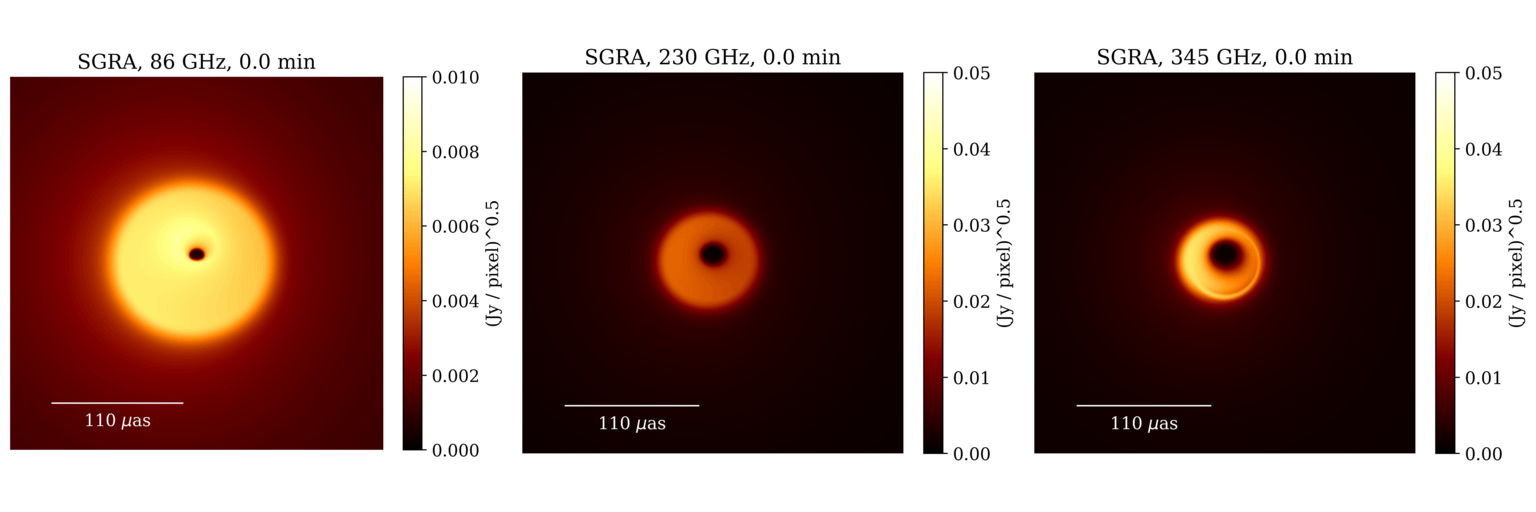

SGRA_GRMHD
This Sgr A* GRMHD model was prepared by Koushik Chatterjee. The GRMHD model is a MAD model with spin 0.5. The images were ray-traced in Stokes I with BHOSS assuming thermal electrons. The 500 frames are spaced 10M (221 s) apart. The pixel resolution is 2048x2048 px, with a FOV of 400 uas. The raw and scattered movies are shown below.
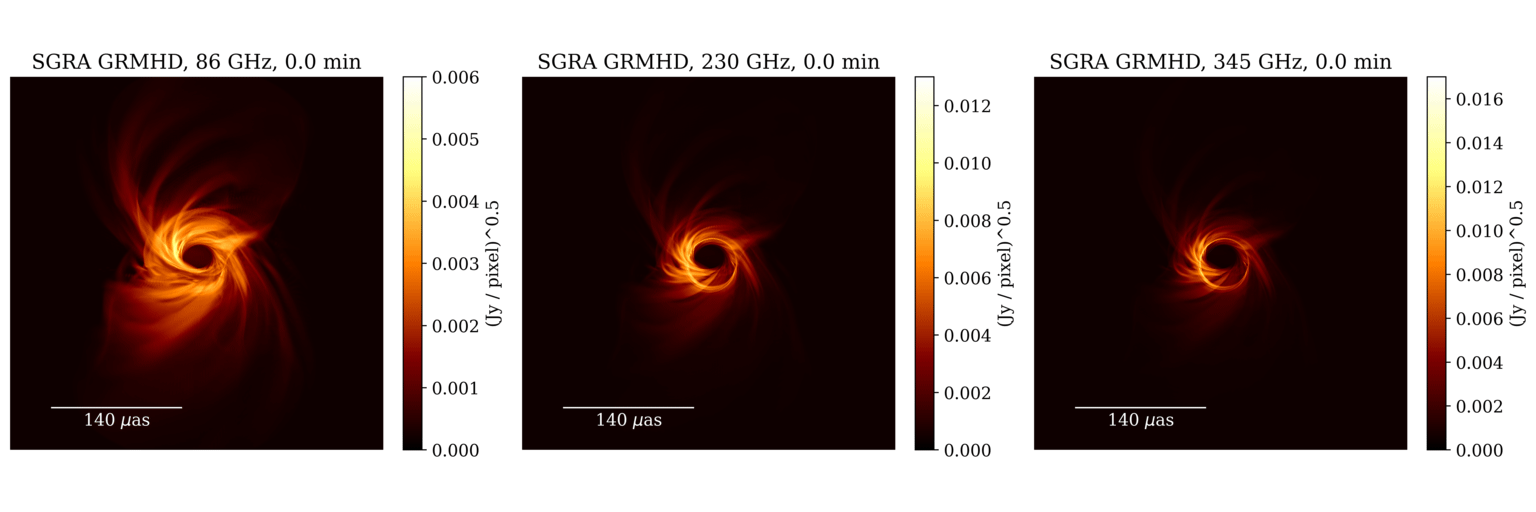
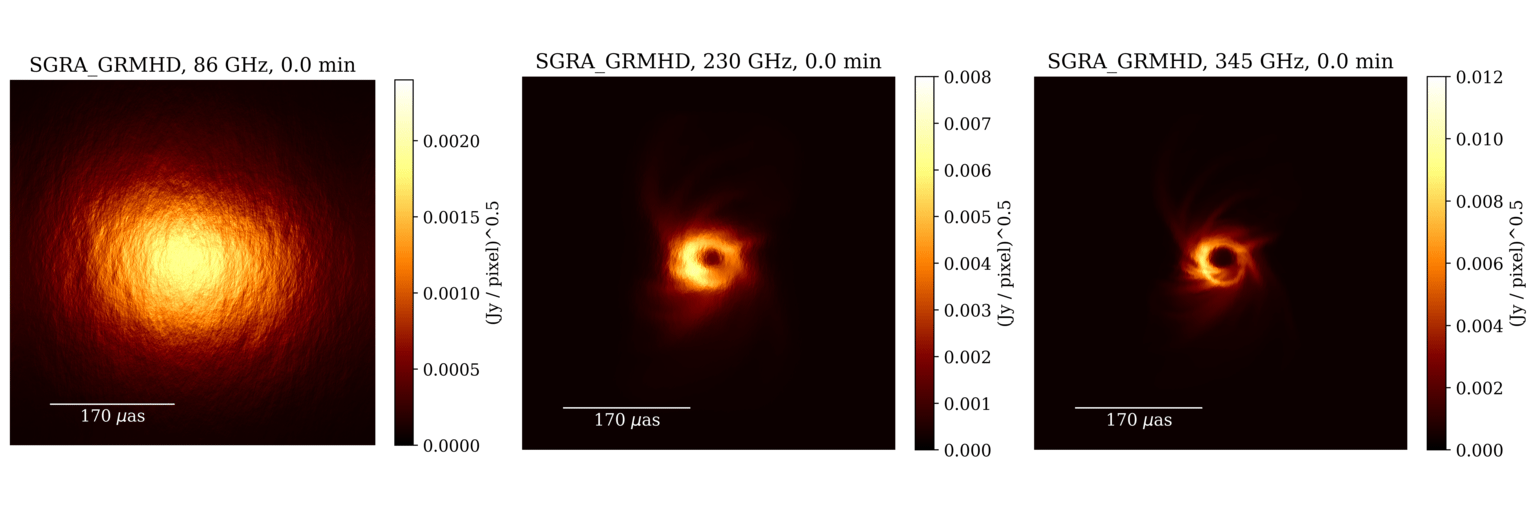
M87_GRMHD
The M87 model is a GRMHD movie with 20 frames that are spaced 20M (~1 week) apart. The pixel resolution is 2048x2048 px, with a field of view of 1 mas x 1mas. The images were ray-traced from a HAMR simulation (MAD, spin 0.94; K. Chatterjee) using ipole by Razieh Emami. Rhigh was set to 160 and accelerated electron heating was included, setting kappa=3.5. We only use the Stokes I information from the model. The movies are shown below.
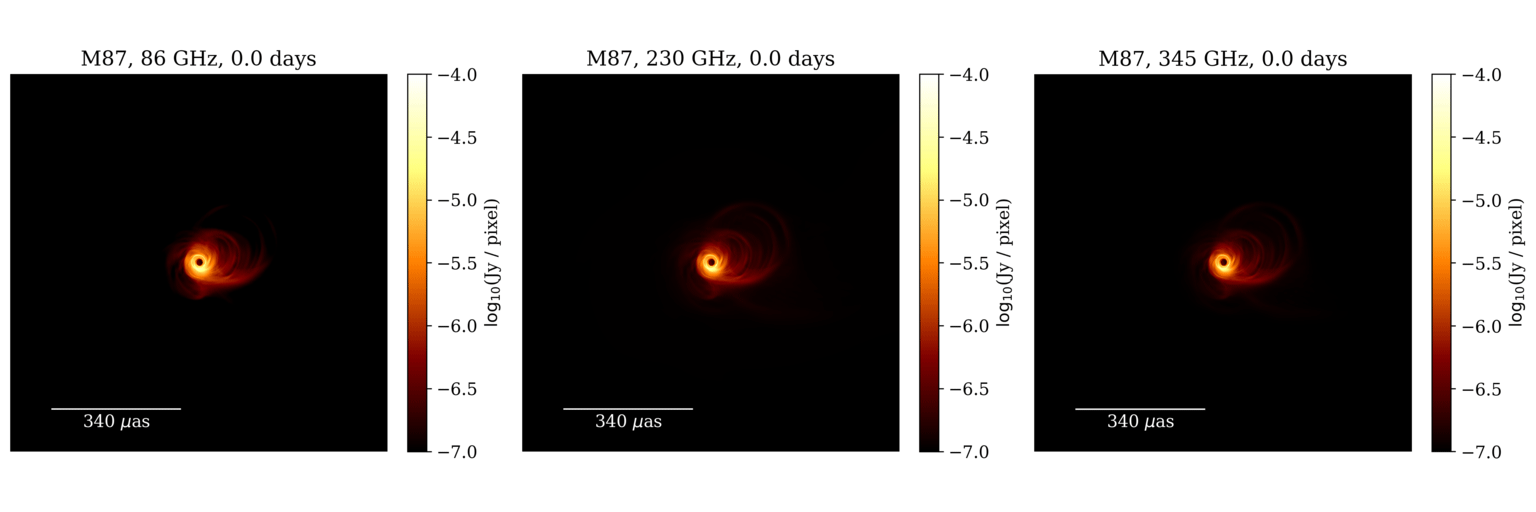
Array and data synthesis
Station locations
Two arrays were used to generate the synthetic data. They are labeled eht_2022 and ngeht_ref1. eht_2022 consists of the 11 stations expected to participate in the 2022 EHT observations. In ngeht_ref1, 10 stations are added to this array. The station locations were chosen based on a uv-coverage analysis led by Alex Raymond, investigating which combination of sites from Raymond et al. (2021) provided optimal uv-coverage, folding in weather dropouts. The LMT, SPT, and KP were not included in the 345 GHz observations with eht_2022. The station locations are shown in the image below.
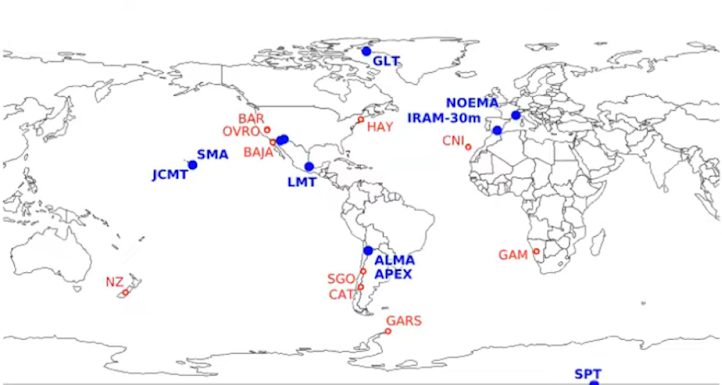
Data properties
Several data corruption and calibration effects were included in the synthetic data generation, for which SYMBA (Roelofs et al. 2020) was used. See the SYMBA antenna files included in the release for detailed antenna and weather parameters.
- Thermal noise with contributions from the receiver and atmosphere
- Atmospheric opacity, corrected with a priori amplitude calibration in rPICARD (Janssen et al. 2019), with remaining systematic errors due to a varying opacity across the band and within a scan. The opacities are based on the median pwv, ground pressure, and ground temperature on 1 April (2000-2020) for each site, taken from the MERRA-2 data (https://disc.gsfc.nasa.gov/datasets/M2I3NPASM_5.12.4/summary).
- Atmospheric turbulence, corrected by a fringe fit with rPICARD. The coherence time was set between 3 and 15 seconds, scaling linearly with the pwv at each site.
- Antenna pointing offsets: 2” rms for each station, stable over a scan
- For Sgr A* models: each frame was scattered with a refractive scattering screen. The screen is static and self-consistent between frequencies.
- Network calibration was applied, using the (varying) source model flux to calibrate ALMA-APEX and JCMT-SMA
- All data is Stokes I only